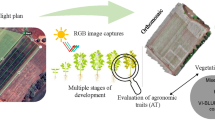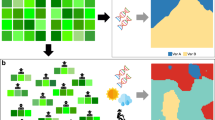Summary
We have previously shown that statistics estimated from the F1, F2, B1 and B2 families of a cross between two inbred lines or from a triple test cross on the F2 of such a cross can be successfully used to predict the properties of the pure breeding lines extractable from the cross by single seed descent. In this paper we extend the method to properties such as mean performance and environmental sensitivity that can be measured only by replicating each family or generation over two or more contrasting environments.
The optimal design for making predictions for such characters is the families of the F2 triple test cross replicated over environments. The simplest design, which assumes that dominance and other non-additive sources of variation are not large, is F3 families replicated over environments. These two designs have, therefore, been compared using the cross between varieties 2 and 12 of Nicotiana rustica, two sowing dates a month apart as the environmental treatment, and mean performance and environmental sensitivity in respect of flowering time and final height as the properties to be predicted. The predicted properties of the pure breeding lines that would be derived from this cross, both singly and jointly, are compared with those of a random sample of its F7 families produced by single seed descent.
There is no difference between the predictions based on the triple test cross and F3 families, and the observed properties in respect of final height do not differ from either. For flowering time the agreement is not so good, the most likely cause being the unreliability of estimates based upon only two environments. Should the number of environments be increased to overcome this possibility or to cover a more realistic set of environmental variables of importance to the growth of the crop it can only improve the attractiveness of the simpler F3 design over the triple test cross.
Similar content being viewed by others
Article PDF
References
Boughey, H, and Jinks, J L. 1978. Joint selection for both extremes of mean performance and of sensitivity to macroenvironmental variable. III. The determinants of sensitivity. Heredity, 40, 363–369.
Brumpton, R J, Boughey, H, and Jinks, J L. 1977. Joint selection for both extremes of mean performance and of sensitivity to a macroenvironmental variable. 1. Family selection. Heredity, 30, 219–226.
Jinks, J L, and Perkins, J M. 1969. The detection of linked epistatic genes for a metrical trait. Heredity, 24, 465–475.
Jinks, J L, and Perkins, J M. 1970. A general method for the detection of additive, dominance and epistatic components of variation. III. F2 and backcross populations. Heredity, 25, 419–429.
Jinks, J L, and Pooni, H S. 1976. Predicting the properties of recombinant inbred lines derived by single seed descent. Heredity, 36, 253–266.
Jinks, J L, Jayasekara, N E M, and Boughey, H. 1977. Joint selection for both extremes of mean performance and of sensitivity to a macroenvironmental variable. II. Single seed descent. Heredity, 39, 345–355.
Kearsey, M J, and Jinks, J L. 1968. A general method of detecting additive, dominance and epistatic variation for a metrical trait. I. Theory, Heredity, 23, 403–409.
Mather, K, and Jinks, J L. 1971. Biometrical genetics. 2nd edition. Chapman and Hall Ltd., London.
Perkins, J M, and Jinks, J L. 1970. Detection and estimation of genotype-environmental, linkage and epistatic components of variation for a metrical trait. Heredity, 25, 157–177.
Pooni, H S, and Jinks, J L. 1978. Predicting the properties of recombinant inbred lines derived by single seed descent for two or more characters simultaneously. Heredity, 40, 349–361.
Pooni, H S, and Jinks, J L. 1979. Sources and biases of the predictor of the properties of recombinant inbreds produced by single seed descent. Heredity, 42, 41–48.
Pooni, H S, Jinks, J L, and Cornish, M A. 1977. The causes and consequences of non-normality in predicting the properties of recombinant inbred lines. Heredity, 38, 329–338.
Pooni, H S, Jinks, J L, and Jayasekara, N E M. 1978. An investigation of gene action and genotype × environment interaction in two crosses of Nicotiana rustica by triple test cross and inbred line analysis. Heredity, 41, 83–92.
Pooni, H S, Jinks, J L, and Pooni, G S. 1978. Predicting the proportions and properties of the transgressive segregants amongst recombinant inbred lines derived by single seed descent. Proceeding XIV Int Cong Genet Moscow Abst II, 118.
Author information
Authors and Affiliations
Rights and permissions
About this article
Cite this article
Jinks, J., Pooni, H. Comparing predictions of mean performance and environmental sensitivity of recombinant inbred lines based upon F3 and triple test cross families. Heredity 45, 305–312 (1980). https://doi.org/10.1038/hdy.1980.73
Received:
Issue date:
DOI: https://doi.org/10.1038/hdy.1980.73
This article is cited by
-
Predicting transgressive segregants in early generation using single seed descent method-derived micro-macrosperma genepool of lentil (Lens culinaris Medikus)
Euphytica (2007)
-
The inheritance of quantitative traits in Brassica napus ssp. rapifera(swedes): augmented triple test cross analysis of yield
Heredity (1994)
-
The genetical basis of hybrid vigour in a highly heterotic cross of Nicotiana tabacum
Theoretical and Applied Genetics (1994)
-
Comparative simulation studies on the effects of selection for quantitative traits in autogamous crops: early selection versus single seed descent
Heredity (1992)
-
Genetics of nitrate content in lettuce
Euphytica (1992)



